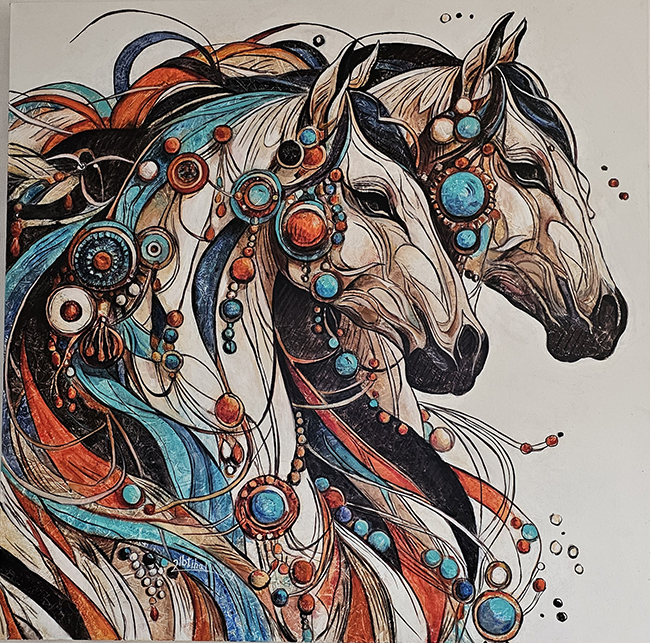Ibtihal Al-Khalidi was born in Iraq and now lives and works in Germany. Her journey—personal and artistic—moves between these two landscapes, and that sense of movement shows up in her work. There’s a kind of quiet resolve in what she paints, an undercurrent of displacement and rebuilding. She doesn’t lean on noise or heavy symbolism. Instead, her work speaks through color, form, and gesture—what’s said with the brush feels honest and unforced.

She holds a degree in Fine Arts and has been part of exhibitions in Iraq, Germany, Qatar, Tunisia, and Jordan. Five solo shows, a steady presence in group exhibitions, and memberships in associations like the Iraqi Artists Syndicate, Iraqi Plastic Artists Association, GESLEGE Munich, KKG, and Brucker Farb-Künstler—she’s built a steady, respected path in the art world. But titles and credentials only tell part of the story. The real story is on the canvas.
Al-Khalidi’s paintings explore layers—emotional, cultural, physical. Some works echo memory. Others feel rooted in transition, like they’re capturing the space between past and present. Her work doesn’t try to resolve that in-between space. Instead, it sits with it.
You can feel this especially in her more abstract pieces. Shapes and lines feel deliberate but not rigid. There’s freedom, but there’s also structure. It mirrors how memory works—sometimes clear, sometimes blurred, but always carried. The balance between soft brushstrokes and sharper edges creates tension, but not conflict. It feels more like a negotiation, a visual conversation between where she’s been and where she is now.
Her colors are earthy, but often pierced with light. Warm tones meet cool ones. The contrast feels emotional, almost like a pull between comfort and distance. These choices don’t just come from technical training. They come from lived experience.
She doesn’t make art just for herself, though. Alongside her studio practice, Al-Khalidi teaches drawing at VHS Moosach in Munich. That act of teaching—of passing on skill and expression—is central to her. In a new country, art has become both a bridge and a home. She gives others that bridge, too.
Her exhibitions reflect that cross-border life. In Iraq, her early shows established her as a grounded and thoughtful painter. In Germany, her more recent exhibitions show a deepening of that voice. The work grows, but it doesn’t abandon its roots. That’s rare. Some artists reinvent themselves completely when they move. Al-Khalidi carries what matters with her—and then adds to it.
Even in shows across Qatar, Tunisia, and Jordan, her work remains consistent in one thing: it doesn’t try to prove anything. It doesn’t scream for attention. It simply holds space. That’s probably the best way to describe her visual language. It holds space—for story, for tension, for healing, for remembering.
She isn’t chasing trends or fitting into a box. She paints because there’s something she needs to say—something maybe even she doesn’t fully understand until it’s on the canvas. That honesty comes through. And viewers feel it.
Her membership in artist associations isn’t about status—it’s about connection. It’s about staying rooted in a community, even as life moves her from one country to another. That’s one of the quiet truths her paintings carry: you can be grounded and in motion at the same time.
Ibtihal Al-Khalidi’s work is for those willing to sit with subtlety. It won’t always hit you at first glance. But give it a moment, and it will start to speak. You’ll find yourself leaning closer, tracing the brushwork, sensing the emotion behind the choices. And then you’ll see it: this is art made with care, with reflection, and with the kind of strength that doesn’t announce itself—but lasts.
Whether in the classroom, the studio, or on gallery walls in cities across continents, Al-Khalidi continues to shape something meaningful. Her work tells a story—not loud or linear—but steady, layered, and real.

